The short answer is yes, you can put a mattress on the floor. The floor (usually) creates excellent support for the mattress, saves money, and creates a clean aesthetic.
However, placing the mattress on the floor also opens up potential warranty, hygiene, and performance issues. Continue below for the pros, cons, and how best setup the mattress on a floor.
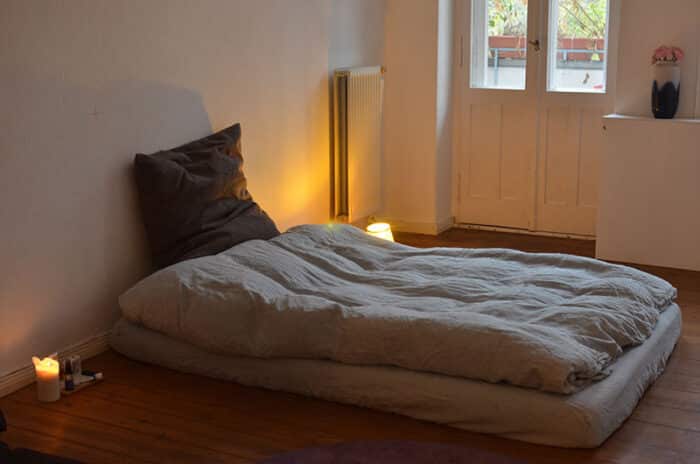
In This Guide
Benefits | Risks | Tips | Types | FAQs
Benefits of a Mattress on the Floor
Putting your mattress on the floor may sound appealing for a variety of reasons. Especially if you just got a new mattress and are ready to use it right away. And there are some really nice advantages.
Here is a list of benefits of putting your mattress directly on the floor.
#1. May reduce back pain
Putting your mattress on the floor may provide your mattress with a firmer feel than it has on a traditional bed frame. This extra firmness can help to reduce back pain.

How does it work? When you sleep with your mattress on the floor the mattress receives more consistent edge-to-edge support. The entirety of the mattress is supported by the floor (as opposed to slat, metal, or wood support beams with spaces between them).
This can help your spine and neck to stay in a neutral position and improve posture as well.
#2. May improve blood circulation
When you have better posture and spinal alignment, your heart doesn’t have to work as hard to circulate the blood. As a result, there is less strain on the heart and better blood flow.
#3. Can save money
New mattresses can be a real investment in terms of cost. Adding in the cost of a boxspring / foundation and bedframe can mean big bucks that you might not be prepared to spend.

Putting your mattress directly on the floor saves money and reduces your shopping list to just the mattress alone.
#4. Takes up less space
No matter how you slice it, a bed on the floor will always take up less space than that same bed on a raised platform or bed frame.
While it may not give you a larger walkable footprint, it will visually lighten the room and make your bed appear less prominent.
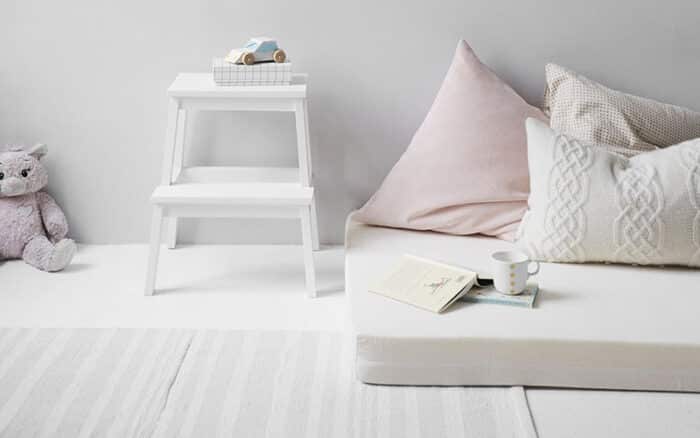
Especially if you have a very small space, putting your bed on the floor may be the design aesthetic you’re going for.
Risks of a Mattress on the Floor
Despite the possible benefits listed above, putting your mattress on the floor isn’t necessarily a no-brainer. In addition to the pros, there are cons and certain considerations you should think about as well.
#1. Dust and dust mites
Right out of the gate, we have to mention dust and dust mites. This can be a dealbreaker for some sleepers, especially those who struggle with allergies.
Floors are incredibly dirty and if you don’t have any separation between your mattress and the floor (ie: mattress protector, area rug, etc) then all of the debris and allergens on the floor will slowly get into your mattress.

Dust mites feed on dead skin cells and are often found burrowed inside mattresses, on areas rugs, carpets, or curtains.
Not all sleepers are sensitive to dust mites, but if you are, you may experience:
- Itching
- Sneezing
- Congestion or difficulty breathing
- Red, itchy eyes
- Rashes
- Hives
#2. Mold and mildew
Mattresses on the floor have a harder time with airflow, which can lead to higher levels of humidity / moisture inside your mattress. Where there is humidity, there is the possibility to develop mold or mildew.
Like dust mites, mold and mildew can cause health risks ranging from mild to very severe, depending on how sensitive you are to the allergen.

Symptoms of mild mold exposure include things like a stuffy nose, wheezing, and red / itchy eyes or skin.
But if the exposure continues other more serious symptoms may develop. More concerning symptoms may include things like fatigue, nervous disorders, frequent headaches, loss of appetite, or brain damage, among other issues.
#3. Harder to get in and out of
The ideal height for a bed is somewhere in the range of 20-24″, depending on height. The average mattress is about 12″ tall, which is half the height.
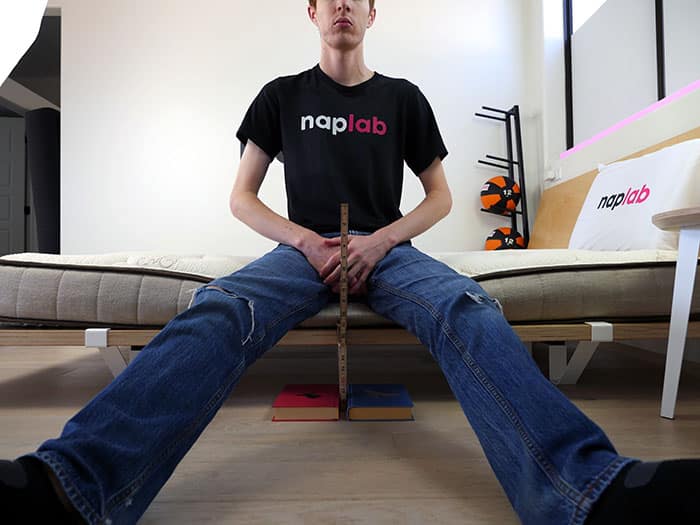
For aging adults or anyone who struggles with chronic pain, you may find the lower height of this mattress to be harder to adjust to. Simply getting in or out of bed will be more difficult with a mattress on the floor.
#4. Not ideal for side sleepers
People who sleep on their side generally benefit from a deeper level of contour that can follow their natural curves.
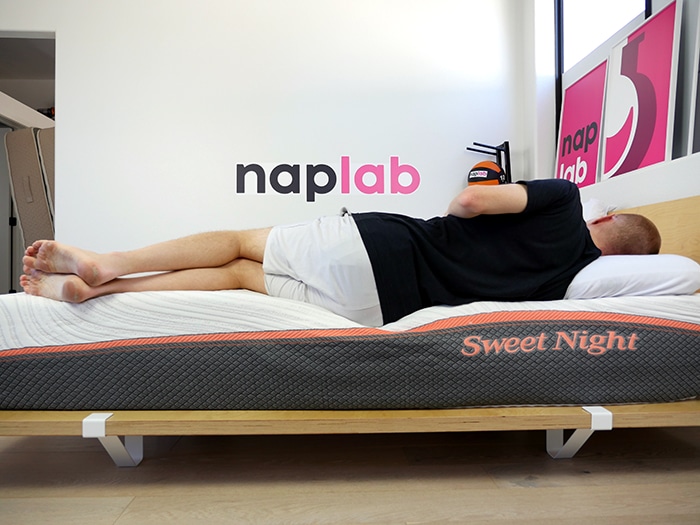
A mattress on a bed frame or foundation has a little more give, but a mattress on the floor tends to be firmer. This extra firmness can create excessive support, which in the case of side sleepers can prevent your midsection from receiving appropriate contouring support.
#5. Too Hot in Summer, Too Cold in Winter
A mattress placed directly on the floor may have trouble regulating the temperature due to the limited airflow. In the winter, you may find the mattress to be very cold due to the cooler temperature on the floor.


By the same token, in the summer, it may be very hot due to the lack of airflow within the mattress.
If you’re sensitive to hot / cold, putting your mattress on the floor might not be the best option for you.
#6. May void the warranty
Lastly, remember to consider the mattress warranty. Not all mattresses are designed to be put directly on the floor and in some cases, doing so can void the warranty.
You definitely want to check with the manufacturer before skipping the bed frame and/or foundation.

Tips for Putting Your Mattress on the Floor
If you’ve considered the benefits and risks of putting your mattress on the floor and want to move forward, here are a few tips.
#1. Air it out.
If your mattress is on the floor, making sure that air can still occasionally circulate under the mattress is key. Consider propping the mattress up on its side somewhat frequently to let air under the mattress.

This helps the mattress air out, lowers humidity levels, and reduces the risk of mold or mildew.
#2. Add a dehumidifier.
Adding a dehumidifier to your room is another way to help reduce the risk of mold or mildew growing under your mattress.
While propping up the mattress is best for airflow, using a dehumidifier can be beneficial during the rest of the time to help keep humidity at bay.
#3. Avoid foam mattresses.
I’m not going to say that you absolutely cannot put a foam mattress on the floor, but many foam mattresses just aren’t going to perform their best down there.
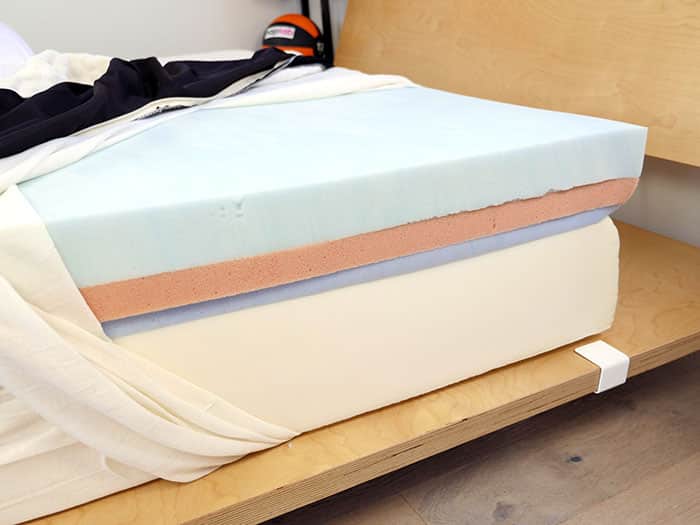
Most foam naturally retains more heat compared to coil and hybrid mattresses.
Are there exceptions to the rule? Absolutely. Popular exceptions would include:
- Foam / coil hybrid mattresses
- Latex foam mattresses
- Mattresses with convoluted for perforated foam layers
#5. Add a barrier.
If you really want your bed on the floor, consider adding a barrier between the hard floor and the mattress. A small barrier doesn’t have to cost a lot, but can help limit the transfer of heat, debris, allergens, and prevent the mattress from slipping around.
Barriers also don’t have to cost a lot. Effective barriers could include:
- Area rug
- Plywood
- Cardboard
- Blanket
- Foam mat
- Boxspring
#6. Use a mattress protector.
The bottom line is that a mattress on the floor is more prone to more creepy crawlies than a mattress 12″ higher on a bed frame.
But adding a mattress protector or encasement is a great way to protect your mattress from dust mites, allergens, and even bed bugs.
- Waterproof mattress protector (high-end)
- Waterproof mattress protector (budget)
- Mattress encasement, 6-sided (bed bug proof)
- Mattress encasement, 6-sided (dust mite proof)
Mattress Protector vs. Mattress Encasement
The difference between a protector and an encasement is the number of sides.
A mattress protector is usually 5-sided and fits on like a standard fitted sheet. But a mattress encasement is 6-sided and fits on like a zippered pillowcase.
For maximum protection for floor mattresses, opt for the encasement since that bottom layer of protection is really going to be critical on the floor.
Types of Mattresses You Can Put on the Floor
Types of mattresses that are designed explicitly to be used directly on the floor, with no bed frame or support system required, include:
These beds are largely intended to be temporary, like for house guests or children, but could serve as a suitable permanent beds for some sleepers.
They require no boxspring, foundation, or bed frame and can be set up very quickly.
FAQs
The exact height may vary between individual sleepers, but in general, a mattress between 20-24″ high is considered comfortable for most sleepers.
Yes. A traditional boxspring will allow for support and ventilation between the floor and your mattress. This addresses all of the “cons” of placing your mattress directly on the floor without the aesthetics or added cost of buying a traditional bed frame.
Maybe. You definitely want to check with the manufacturer before putting your mattress directly on the floor. In some cases, this voids the warranty so if you try to make any claims down the road, the damage would not be covered.
All mattresses need a certain level of support in order to serve at peak performance. For some, the support of the floor is enough. Others, like traditional innerspring or coil-on-coils mattresses, oftentimes require a boxspring or other foundation.
Most modern mattresses don’t require a boxspring, but if your frame doesn’t have adequate support, you may still want something. Consider a low-profile boxspring, bunkie board, or reinforced slat system for additional support.
A mattress directly on the floor can have some movement compared to a mattress on a bed frame. To prevent this, consider adding non-slip rug pads or a mat directly under your mattress. For a better design choice, you could also put a large area rug with a non-slip back under your mattress.
Disclaimer: This guide is written for the sole purpose of providing basic information and tips and is not medical advice. Always consult your doctor for medical advice.





